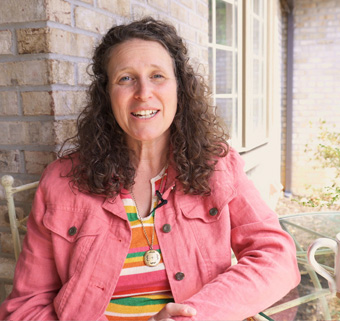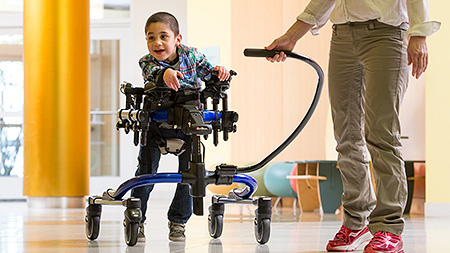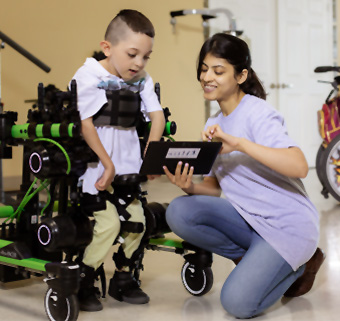Body Weight Supported Treadmill Walking
Why We Love the New Rifton Pacer
| May 2017At our Therafit Rehab clinics in Maryland and New Jersey we specialize in treating children and adults with neurological disabilities such as cerebral palsy, stroke, TBI and Parkinson’s disease. Time and again our patients tell us their number one goal for rehab is walking – whether for the first time, relearning to walk or just walking better. And it’s no wonder. Walking is an integral part of human function and independence.
 For this reason, we were eager to try the new Rifton Pacer gait trainer with its dynamic movement, body-weight support and, best of all, a compatible treadmill base. With it we now have a simple solution to helping our patients walk safely over a treadmill, the first step in achieving independent ambulation.
For this reason, we were eager to try the new Rifton Pacer gait trainer with its dynamic movement, body-weight support and, best of all, a compatible treadmill base. With it we now have a simple solution to helping our patients walk safely over a treadmill, the first step in achieving independent ambulation.
Locomotor Training
Locomotor training, or assisted treadmill walking, targets the regeneration of the neural circuitry through repetition, patterning and feedback. During treadmill walking, sensory signals are continuously sent from the feet as they contact the moving belt, up to the spinal cord. This stimulates the nervous system to regenerate and fire the neural pathways involved in stepping.
We use the Pacer-treadmill combo for this initial re-patterning work. With the patient supported by the Pacer, we work towards generating rhythmic steps, starting with having the patient “feel” the reciprocal motion as we move their legs and provide tactile cues for leg placement and muscle use. As they improve, we ask for more effort and participation from them until stepping becomes more coordinated and automatic.
After mastering treadmill stepping and weaning from therapist support, we apply what they’ve learned to over-ground walking and eventually walking within the community -- still with the same Pacer gait trainer.
What We Love About the New Pacer Gait Trainer
I applaud the dynamic movement of the Pacer. It allows the patient’s pelvis to move freely left or right, up and down. Most gait trainers limit the amount of a patient’s pelvic motion, thus creating an artificial, awkward gait. The rise and fall and flow of the dynamic movement in the Pacer introduces our patients much earlier to the dynamics of normal walking making the transition to independent and community ambulation decidedly easier.
 Additionally, the Pacer has a variety of features making it simple to appropriately position the patient for walking. I also use the directional locks if someone has difficulty controlling lateral movement and set drag or resistance to the wheels if the Pacer tends to get away from the patient.
Additionally, the Pacer has a variety of features making it simple to appropriately position the patient for walking. I also use the directional locks if someone has difficulty controlling lateral movement and set drag or resistance to the wheels if the Pacer tends to get away from the patient.
And finally, the Rifton Pacer makes locomotor training affordable. Traditionally, locomotor training could only be done with large and complex body-weight support systems. These are expensive. Then to pair them with gait trainers (for over-ground walking) is beyond financial reach of most people. The Rifton Pacer does a great job of giving someone the ability to perform both treadmill walking and over-ground walking. And it is all in one device that is both affordable and convenient.
When our patients are ready to discontinue formal therapy, we work with them to get a gait trainer for their home and train the caregivers in its use. That way, we maximize the gains made in therapy and continue improving independence in walking.




